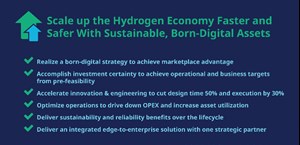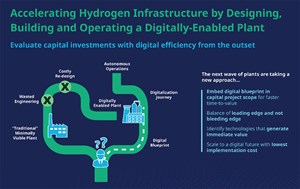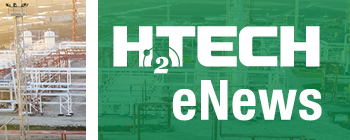Articles
The green H2 superhighway: Paving the path with data, automation and flexibility
Renewables for H2 Generation
J. FRASER, Emerson, Lambley, England; and R. BECK, Emerson, Boston, Massachusetts (U.S.)
The race to develop efficient, value-driven green hydrogen (H2) production is well underway. Companies around the globe have moved from conceptualizing and theorizing to conducting reliability studies and pre-front-end engineering and design (pre-FEED) to attract fresh investment into what will rapidly become a critical segment in the renewable energy economy.
As with nearly every new technology, there is significant potential value to be captured by organizations bold enough to lead innovation. However, every new technology also brings considerable uncertainty and managing that risk is critical to success and to capturing the interest and funding of investors.
Green H2 is no exception. Successful production processes typically depend on managing intermittent energy supplies, complex operational requirements, dramatic market fluctuations and uncertainty, and equipment with limited field operational experience. Each of these factors, along with a wide variety of other variables, must be considered in project design and operational execution to deliver full value across the lifecycle of an organization’s operations.
From the original capital expenditure (CAPEX) calculations, to selecting the appropriate source and quantity of renewable energy and storage, to creating power purchase agreements and ensuring that the operations team gets optimal performance from the technology once the project goes live, green H2 innovators shoulder a great deal of responsibility.
The secret to success in these endeavors lies in starting from the earliest stages with a born-digital strategy founded in a boundless automation vision of seamless data mobility. Modern automation technology—when carefully selected for seamless interconnectivity and ease of use—provides the H2 digitalization pathway necessary for project and operational success across the lifecycle, offering near-limitless flexibility and mobility.
Designing against intermittency. Many organizations pursuing new green H2 projects quickly discover that load factor is a bottleneck for their operational efficiency and return on investment (ROI). The output of the green energy sources used to power electrolyzers is highly intermittent and offers very little buffer between energy input and gas output. Ultimately, these teams must determine ways to optimize the load factor among renewable energy sources (either onsite or purchased from the grid), battery storage and the size of the operating units. Operations must be designed to avoid both insufficient and excessive electricity flowing into the electrolyzers at any given time.
Ultimately, designing such projects optimally relies on forecasting tools that can probabilistically forecast loads and help right-size operations based on potential capabilities. Powerful predictive simulation tools provide detailed analyses to help guide strategic decisions for CAPEX prioritization.
In green H2 projects, these tools can help project teams explore options for available wind or solar production at a given site and determine the probabilities of achieving certain amounts of power generation at specific times. Armed with this information, project teams can make optimized decisions between CAPEX and operational expenditure (OPEX) to determine how much wind and solar production to build or acquire, and how much battery storage the site will need.
Monte Carlo simulation offers one of the most powerful forecasting tools, not only helping project teams determine how many batteries they will need but also helping them properly size the electrolyzers and other critical equipment for H2 production and transportation. With accurate predictive data, correctly sizing an operation is no longer a guessing game but rather an informed cost calculation that drives faster project completion and improved ROI (FIG. 1).

Embracing operational flexibility. An alternative way to navigate the intermittency of renewable power generation is to embrace it rather than hedge against it. Some organizations are using advanced process control (APC) and dynamic modeling software, in parallel with forecasting tools, to build solutions to manage the intermittency of renewable energy generation into their project design and operating strategy.
Instead of designing green H2 generation plants that must always operate at 70%─90% capacity, these organizations are building electrolyzer units that can scale down to 30%─40% capacity when renewable generation is low. By using dynamic simulation, APC and forecasting tools, the organizations’ engineers have developed dozens of control strategies, each of which can be invoked as needed when forecasting tools identify an upward or downward change in energy production. Operations teams can respond in less than an hour, rapidly scaling and optimizing production from 100% to 10% capacity, and vice versa.
As with companies attempting to navigate intermittency, accurate forecasting tools are critical to this strategy, as is seamless data mobility among forecasting, simulation and operations interfaces. Teams achieving the most success with flexible operations strategies design their solutions to deliver the right data to the right people at the right time for fast, intuitive decision support. Armed with the information they need, operators can easily make changes daily—or even multiple times per day—to meet the challenges of changing weather patterns, energy price fluctuations and shifting customer needs.
Finding fiscal flexibility. ROI is critically important in emerging industries like green H2 generation. For example, when a green H2 site contains solar arrays or wind farms, it is not for the stability of the grid, but rather a financial vehicle to deliver increased value. The teams making those decisions rely on accurate data to help identify opportunities, understand upstream and downstream activities related to their site, and empower them to capitalize on those changes at the right time.
There are many layers of complexity in such a business model. H2 production rates are critical, but so is the destination of that H2. If the H2 must be converted into ammonia for transport, it adds CAPEX and operational complexity while reducing safety risks—both of which must be considered as part of financial and operational calculations. Variability in wind and solar production, along with available battery storage, can also dramatically impact an organization’s daily decisions (FIG. 2).
For example, if a H2 plant has ample battery storage and the batteries are fully charged after weeks of ideal weather, the operations team may face complex decisions. Obviously, that stored energy can serve as a hedge for production if forecasting tools predict poor weather in the coming days. But what if the opposite is true?
If forecasting tools suggest the next week will bring enough energy generation to power operations, the organization might earn significant revenue selling its stored green energy back to the grid. Alternatively, if grid prices are low, the right tools can help teams choose when to purchase energy from the grid to fully charge the batteries and hedge against poor weather and limited energy production.
However, accomplishing such goals requires not only the tools to anticipate environmental and market factors, but also the tools necessary to shift operations to meet those needs. If the organization is armed with information but cannot turn it into action, predictive data offers little value.
Therefore, savvy project teams expand their born-digital project strategies to encompass every element of green H2 generation operations. If everyone is armed with the tools they need to stay flexible, plants—or even entire fleets—can continually meet changing needs and capture competitive advantage in ways that more traditionally designed sites cannot match.
Reducing risk through reliability. However, it is not enough to simply identify opportunities for increasing revenue and attempt to adjust operations accordingly. Successful flexible operation relies on awareness and availability. If generation assets are not ready to perform, operations teams will be unable to capitalize on the opportunity.
Green H2 generation is an emerging industry, and emerging industries regularly rely on evolving technologies. For example, if an electrolyzer is installed at a green H2 plant and months later operators discover that the membrane filtration is degrading faster than the manufacturer predicted, the operations team will quickly find that it is not always ready to produce to the expected scale, unless they can predict that degradation.
Moreover, even if every new asset works exactly as planned, day-to-day operations still create wear and tear on equipment, and assets will eventually degrade. If teams cannot predict these degradations and they lead to unexpected failures, the operational flexibility necessary to meet the organization’s goals will evaporate.
Reliability—just like weather, market costs and demand—is a form of risk. In addition, just like other risks, reliability can be managed using tools that fit the born-digital strategy. From wireless vibration monitoring and edge analytics devices to full-scale, enterprise-level asset performance management platforms, digital automation technologies can provide visibility into asset health and generate decision support information for the teams responsible for keeping those assets running at peak efficiency. As reliability increases, risk decreases, helping teams maintain flexibility and deliver ROI across a facility’s lifecycle.
Bringing data together. There are many critical building blocks to delivering value in green H2 operations. Forecasting and prediction software provides teams with the visibility they need to identify opportunities to drive value. Control and operations management tools help operators quickly make the changes necessary to capitalize on the opportunities identified by forecasting tools. Clear visibility of asset health, along with analytics tools that predict failures and guide fast repairs, drives the reliability required to ensure that when an opportunity arises, the plant is ready to run. Digital twins advise operators on adjustments to optimize operations. Each of these elements is a key piece of the puzzle for mitigating risk.
However, the more varied the solutions necessary to support each of those areas, the more risk is added to both projects and operations. Like puzzle pieces, effective technologies must not only be available but must also fit together. If one or more solutions require complex engineering to work with the others, it will not only be more difficult and costly to implement, but also more challenging to maintain over time.
To meet this challenge, today’s most effective teams are designing their green H2 solutions with a boundless automation vision from the earliest stages of project development. By designing born-digital solutions that seamlessly move data from field devices to the edge and into the cloud, teams can ensure their critical tools—forecasting software, green energy control solutions, asset reliability tools, enterprise analytics and business systems—continually provide a seamless automation solution.
At the heart of that boundless automation vision is the selection of solutions built by providers with decades of industry expertise and designed for intuitive integration. A unified technology solution will help through every stage of a green H2 project—from inception and design through every element of the operating lifecycle—to maximize performance economically, commercially and from a reliability perspective (FIG. 3).

From field to enterprise and project to operations. Pursuing an emerging process like green H2 generation requires some tolerance for risk. The technology will continue to evolve, and those willing to navigate that complexity will reap the greatest rewards. However, an inability to perfectly predict the future does not mean a team must approach green H2 projects unprepared.
Much of the variability can be anticipated, mitigated and even monetized through digital tools for forecasting, economic optimization, and maintenance and reliability management. An integrated, born-digital strategy will help teams quickly and safely scale up their part of the H2 economy, preparing them to capture the competitive advantage as they navigate the future of energy production. H2T
About the authors

JAMES FRASER has 25 yr of automation experience in the power industry. As Vice President of Renewables, he is responsible for leading the continued development and execution of Emerson’s renewables strategy. Fraser’s focus is driving the global growth of Emerson’s expanding renewable capabilities through the software and automation technologies of the Ovation Green Suite of Solutions. This encompasses quality implementation of clean energy portfolios, including wind, solar, hydro and energy storage projects. Fraser earned a BS degree in control systems engineering from the University of Sheffield and is pursuing an MBA at the University of Cranfield.

RON BECK is the Senior Director of Solutions Marketing for Emerson’s Aspen Technology business. He works with global energy and chemical companies on digitalizing sustainability and decarbonization pathways. Beck has more than 40 yr of experience in the intersection of the energy industry, digital technology and environmental science. His work in sustainability and energy security goes back to the first U.S. energy crisis in 1973–1974 when he was involved in the U.S. DOE strategy work and innovation, including conducting one of the first economic studies of wind energy, waste conversion through pyrolysis and new approaches to enhanced oil recovery.

